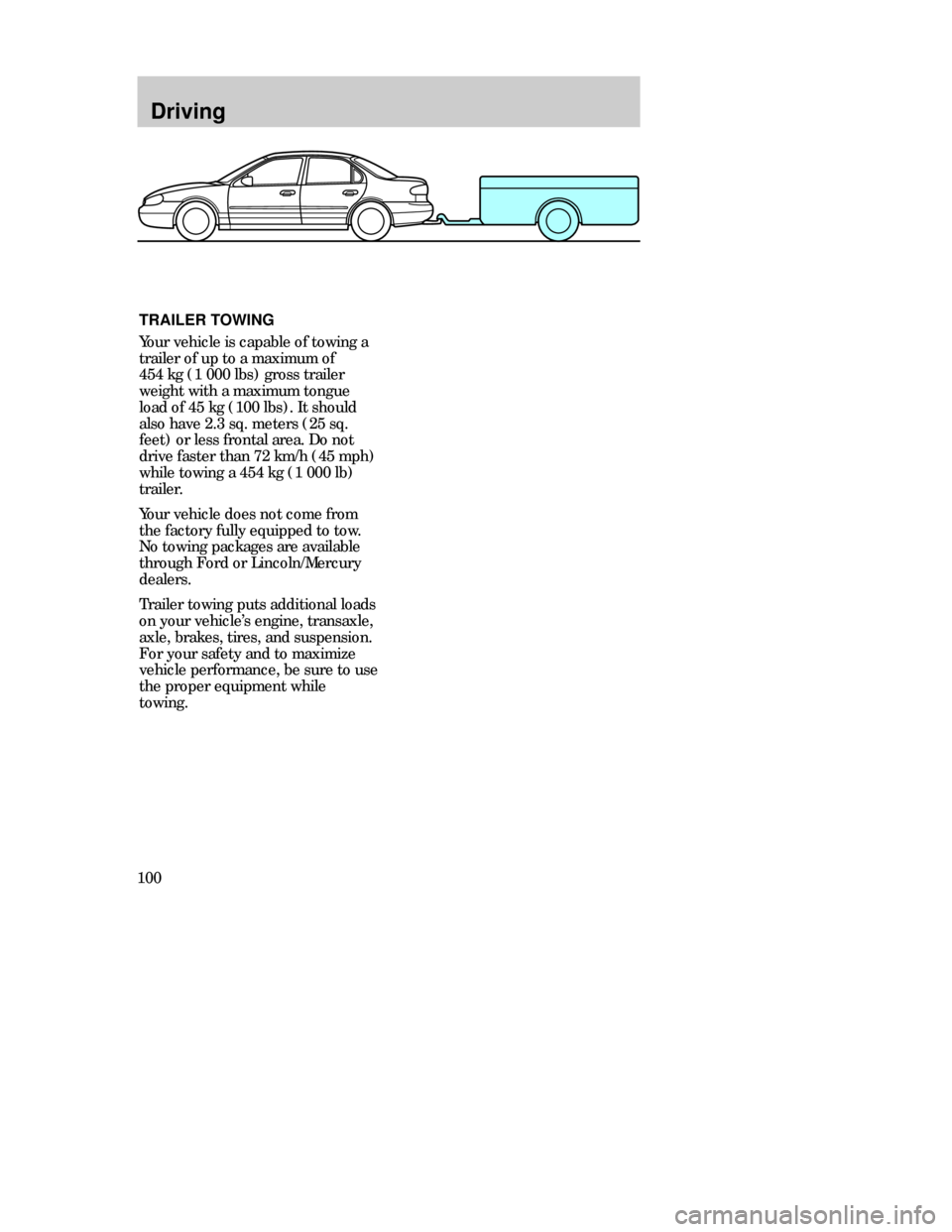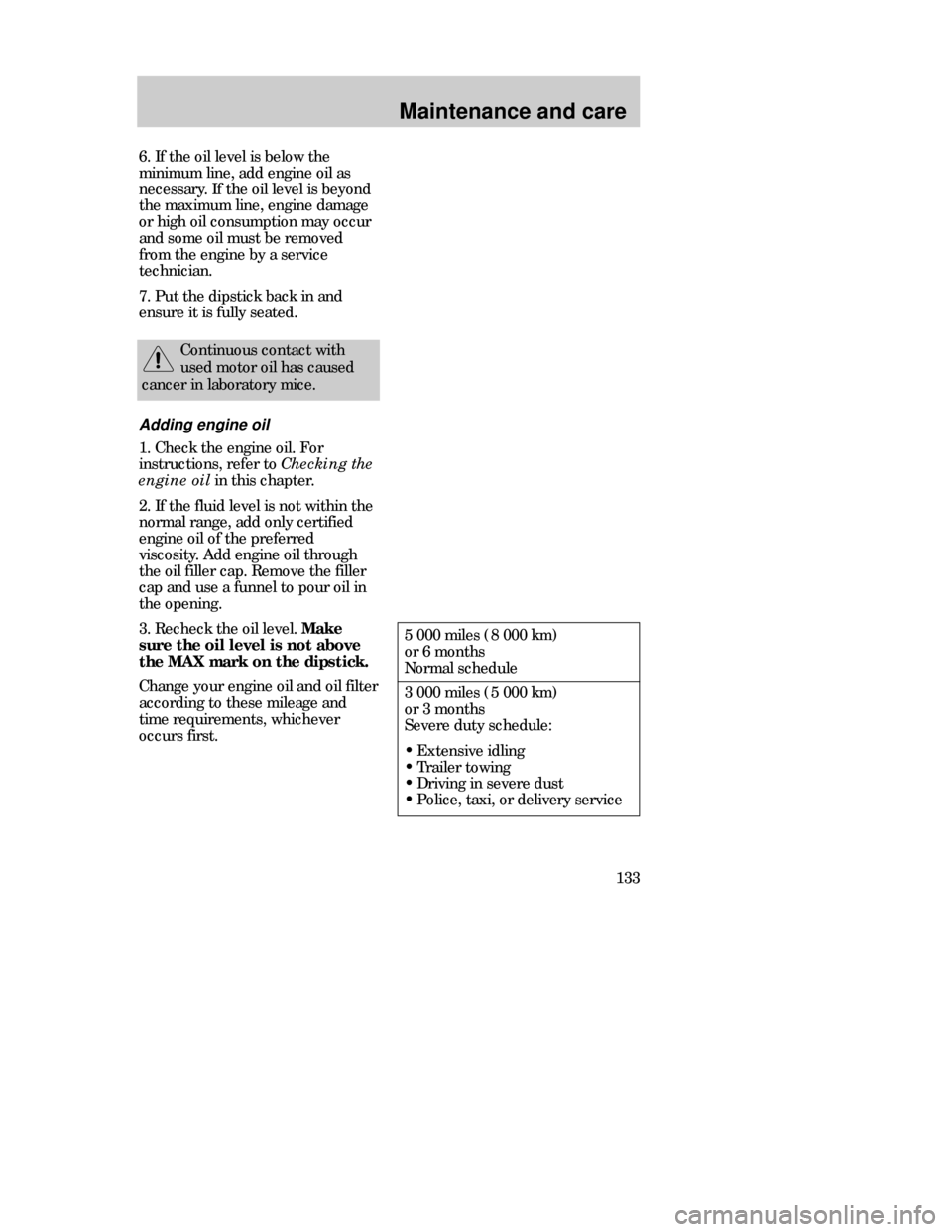towing Mercury Mystique 1998 Owner's Manuals
[x] Cancel search | Manufacturer: MERCURY, Model Year: 1998, Model line: Mystique, Model: Mercury Mystique 1998Pages: 196, PDF Size: 1.65 MB
Page 97 of 196

Driving
97
GCW(Gross Combined Weight)
The GCW is the maximum
combined weight of the towing
vehicle (including passengers and
cargo) and the loaded trailer. The
GCW is specified by the
manufacturer to indicate the
combined maximum loaded weight
that the vehicle is designed to tow. GAWR(Gross Axle Weight
Rating)
Carrying capacity for each axle
system (front and rear). The
GAWR is specific to each vehicle
and is listed on the Safety
Compliance Certification Label on
the driver’s door pillar. GVWR(Gross Vehicle Weight
Rating)
Maximum total weight of the base
vehicle, passengers, optional
equipment and cargo. The GVWR is
specific to each vehicle and is listed
on the Safety Compliance
Certification Label on the driver’s
door pilar.
CDW IVB1-10Driving en MM 5/15/97 7:51 PM Page 97
Page 100 of 196

Driving
100TRAILER TOWING
Your vehicle is capable of towing a
trailer of up to a maximum of
454kg (1000 lbs) gross trailer
weight with a maximum tongue
load of 45kg (100 lbs). It should
also have 2.3sq. meters (25sq.
feet) or less frontal area. Do not
drive faster than 72km/h (45mph)
while towing a 454kg (1000lb)
trailer.
Your vehicle does not come from
the factory fully equipped to tow.
No towing packages are available
through Ford or Lincoln/Mercury
dealers.
Trailer towing puts additional loads
on your vehicle’s engine, transaxle,
axle, brakes, tires, and suspension.
For your safety and to maximize
vehicle performance, be sure to use
the proper equipment while
towing.
CDW IVB1-10Driving en MM 5/15/97 7:51 PM Page 100
Page 101 of 196

Driving
101 Follow these guidelines to ensure
safe towing procedure:
•Stay within your vehicle’s load
limits.
•Thoroughly prepare your vehicle
for towing. Refer to Preparing to
towin this chapter.
•Use extra caution when driving
while trailer towing. Refer to
Driving while towing a trailer
in this chapter.
•Service your vehicle more
frequently if you tow a trailer.
Refer to the severe duty schedule
in the ”Service Guide”.
•Do not tow a trailer until your
vehicle has been driven at least
800km (500miles).
•Refer to the instructions included
with towing accessories for the
proper installation and
adjustment specifications.
CDW IVB1-10Driving en MM 5/15/97 7:51 PM Page 101
Page 102 of 196

Driving
102Preparing to tow
Use the proper equipment for
towing a trailer and make sure that
it is properly attached to your
vehicle. See your dealer or a
reliable trailer retailer if you
require assistance.
Auxiliary coolers are recommended
for the power steering system and
automatic transaxle system if you
are planning on:
•Traveling farther than 80 km
(50miles).
•Towing in hilly terrain.
•Towing frequently.
Towing trailers beyond the
maximum recommended
gross trailer weight exceeds the
limit of the vehicle and could
result in engine damage, transaxle
damage, structural damage, loss of
control, and personal injury.
Do not exceed the maximum loads
listed on the Safety Compliance
Certification Label. For load
specification terms found on the
label, refer to Loading your
vehiclein this chapter. Remember
to figure in the tongue load of your
loaded vehicle when figuring the
total weight.
CDW IVB1-10Driving en MM 5/15/97 7:51 PM Page 102
Page 105 of 196

Driving
105 Driving while towing a trailer
Do not drive faster than 72km/h
(45mph) while towing a 454 kg
(1000lb) trailer. Do not drive
faster than 72km/h (45mph) with
any weight trailer while towing in
hilly terrain or on hot days.
Speed control (if equipped) may
not work properly while towing on
long, steep grades.
If driving with an automatic
transaxle:
•Use D (Drive) or a low gear
rather than D (Overdrive) while
towing up or down steep inclines.
•Anticipate stops and brake
gradually.
If driving with a manual transaxle:
•Select a gear that avoids jerking
or excessive engine speed.
•Avoid driving excessively in first
or second gear. If you need to
drive excessively in first or
second gear, the trailer may be
too big or too heavily loaded for
the vehicle drivetrain.
•Shift to a lower gear while towing
up or down steep hills.
•Anticipate stops and brake
gradually.
CDW IVB1-10Driving en MM 5/15/97 7:51 PM Page 105
Page 108 of 196

Roadside emergencies
108
If your engine cranks but does not
start after a collision or substantial
jolt:
1. Turn the ignition key to the off
position.
2. Check under the vehicle for
leaking fuel.
3. If you do not see or smell fuel,
push the red reset button down. If
the button is already set, you may
have a different mechanical
problem.
4. Turn the ignition key to the on
position for a few seconds, then
turn it to the off position.
5. Check under the vehicle again
for leaking fuel. If you see or smell
fuel, do not start your vehicle
again. If you do not see or smell
fuel, you can try to start your
vehicle again.
If you see or smell fuel, do
not reset the switch or try to
start your vehicle. Have all the
passengers get out of the vehicle
and call the local fire department
or a towing service.
CDW IVC1-6Roads en MM 5/15/97 7:53 PM Page 108
Page 124 of 196

Roadside emergencies
124If towing is necessary, it is
recommended that your vehicle be
towed with a wheel lift or flatbed
equipment. Do not tow with
slingbelt equipment. Ford Motor
Company has not developed or
approved a T-hook or slingbelt
towing procedure.
TOWING YOUR VEHICLE
BEHIND ANOTHER VEHICLE
Before you have your vehicle
towed:
•release the parking brake,
•move the gearshift to N
(Neutral),
•turn the ignition to the off
position and
•unlock the steering wheel.
Do not tow your vehicle at a speed
faster than 55 km/h (35 mph) or
for a distance greater than 80 km
(55 miles) unless the drive wheels
are placed on dollies. WRECKER TOWING
CDW VA1-19Maint en MM 5/15/97 7:55 PM Page 124
Page 133 of 196

Maintenance and care
133 6. If the oil level is below the
minimum line, add engine oil as
necessary. If the oil level is beyond
the maximum line, engine damage
or high oil consumption may occur
and some oil must be removed
from the engine by a service
technician.
7. Put the dipstick back in and
ensure it is fully seated.
Continuous contact with
used motor oil has caused
cancer in laboratory mice.
Adding engine oil
1. Check the engine oil. For
instructions, refer to Checking the
engine oilin this chapter.
2. If the fluid level is not within the
normal range, add only certified
engine oil of the preferred
viscosity. Add engine oil through
the oil filler cap. Remove the filler
cap and use a funnel to pour oil in
the opening.
3. Recheck the oil level.
Make
sure the oil level is not above
the MAX mark on the dipstick.
Change your engine oil and oil filter
according to these mileage and
time requirements, whichever
occurs first.5 000 miles (8 000 km)
or 6 months
Normal schedule
3 000 miles (5 000 km)
or 3 months
Severe duty schedule:
•Extensive idling
•Trailer towing
•Driving in severe dust
•Police, taxi, or delivery service
CDW VA1-19Maint en MM 5/15/97 7:55 PM Page 133
Page 191 of 196

Index
191 CPage
Child safety restraints
built-in child seat . . . . . . . . . . .65
child safety seats . . . . . . . . . . . .71
children and safety belts . . .61, 63
Child safety seats
and air bags . . . . . . . . . . . . . . . .56
attaching with tether straps . . .74
automatic locking mode . . . . . .49
Childproof safety locks . . . . . . . .35
Chimes . . . . . . . . . . . . . . . . . . . . .10
Circuit breakers . . . . . . . . . . . . .109
Cleaning your vehicle
engine compartment . . . . . . . .179
exterior lamps . . . . . . . . . . . . .180
fabric . . . . . . . . . . . . . . . . . . . .181
instrument panel . . . . . . . . . . .181
plastic exterior parts . . . . . . . .180
safety belts . . . . . . . . . . . . . . .182
wheels . . . . . . . . . . . . . . . . . . .178
wiper blades . . . . . . . . . . . . . .180
Climate control system
air conditioning . . . . . . . . . . . . .21
controlling airflow . . . . . . . . . . .20
defrosting . . . . . . . . . . . . . . . . . .23
temperature . . . . . . . . . . . . . . . .20
vents . . . . . . . . . . . . . . . . . . . . . .19
Clock . . . . . . . . . . . . . . . . . . . . . .18
Clutch
operation . . . . . . . . . . . . . . . . . .93
recommended shift speeds . . . .94
Cold engine starting . . . . . . . . . .82
Controls
instrument panel . . . . . . . . . . . .14
mirrors . . . . . . . . . . . . . . . . . . . .17
power seats . . . . . . . . . . . . . . . .45
steering column . . . . . . . . . . . . .24DPage
Daytime running lights . . . . . . . .15
Defects, reporting . . . . . . . . . . .189
Defrost
rear window . . . . . . . . . . . . . . . .16
windshield . . . . . . . . . . . . . . . . .23
Dipstick, engine oil . . . . . . . . . .130
Door mounted controls . . . . . . . .34
Driving under special conditions
heavy load . . . . . . . . . . . . . . . . .99
towing a trailer . . . . . . . . . . . .100
E
Electrical system
fuses . . . . . . . . . . . . . . . . . . . . .109
Emergencies, roadside
fuel pump shut-off switch . . . .107
jump starting . . . . . . . . . . . . . .121
towing . . . . . . . . . . . . . . . . . . .124
Emergency brake (see Parking
brake)
Emission control system . . . . . .163
Engine
check engine warning light . . . . .8
fuel pump shut-off switch . . . .107
lubricant specifications . . . . . .185
preparing to start . . . . . . . . . . .79
refill capacities . . . . . . . . . . . .184
starting . . . . . . . . . . . . . . . . . . . .82
Engine block heater . . . . . . . . . .83
Engine coolant
checking and adding . . . . . . . .136
disposal . . . . . . . . . . . . . . . . . .138
low coolant warning light . . . . . .7
refilll capacities . . . . . . . . . . . .184
specifications . . . . . . . . . . . . . .185
Engine fan . . . . . . . . . . . . . . . . .126
CDW_Index_en _MM 5/15/97 8:00 PM Page 191
Page 195 of 196

Index
195 SPage
Safety belts
(see Safety restraints)
Safety chains, when towing
a trailer . . . . . . . . . . . . . . . . . . . .104
Safety Compliance Certification
Label . . . . . . . . . . . . . . . . . . . . . .102
Safety defects, reporting . . . . . .189
Safety restraints
adjusting the safety belts . .47, 51
automatic locking mode
(retractors) . . . . . . . . . . . . . . . .49
cleaning the safety belts . . . . .182
extention assembly . . . . . . . . . .53
for children . . . . . . . . . . . . . . . .61
head restraints . . . . . . . . . . . . .44
lap and shoulder belts . . . . . . . .48
maintenance . . . . . . . . . . .54, 182
vehicle sensitive locking mode .49
warning light and chime . . . .7, 11
Safety seats for children
and air bags . . . . . . . . . . . . .56, 72
attaching with tether straps . . .74
automatic locking mode
(retractors) . . . . . . . . . . . . .49, 71
built-in child seat . . . . . . . . . . .65
in front seat . . . . . . . . . . . . .56, 72
tether anchorage hardware . . .75
Seats
adjusting the seats, manual . . .44
adjusting the seats, power . . . .45
folding rear seats . . . . . . . . . . . .46
head restraints . . . . . . . . . . . . .44
Servicing your vehicle . . . . . . . .125
Shift-lock system . . . . . . . . . . . . .88
Shift positions (see Gearshift)
Snow tires and chains . . . . . . . .155SPage
Spare tire
changing the tire . . . . . . . . . . .116
removing the spare tire . . . . . .118
temporary spare tire . . . . . . . .117
Spark plugs, certifications . . . .183
Specification charts, lubricants185
Speed control
disengaging speed control . . . .32
return to a set speed . . . . . . . . .32
set a speed . . . . . . . . . . . . . . . . .30
set a higher speed . . . . . . . . . . .31
set a lower speed . . . . . . . . . . . .31
turn speed control off . . . . . . . .29
turn speed control on . . . . . . . .29
Speedometer . . . . . . . . . . . . . . . .13
Starting your vehicle
preparing to start the vehicle . .79
starting the engine . . . . . . . . . .82
Steering column controls . . . . . .24
Steering wheel
horn . . . . . . . . . . . . . . . . . . . . . .26
speed control . . . . . . . . . . . . . . .29
tilting . . . . . . . . . . . . . . . . . . . . .25
Sunroof . . . . . . . . . . . . . . . . . . . .33
Supplemental restraint
system . . . . . . . . . . . . . . . . . .11, 53
T
Tachometer . . . . . . . . . . . . . . . . .13
Tail lamps (see Rear lamps)
Temperature control
(see Climate control)
Testing the warning lights . . . . . .10
Tether anchor installation
(see Child safety restraints)
Tilt steering wheel . . . . . . . . . . . .25
CDW_Index_en _MM 5/15/97 8:00 PM Page 195